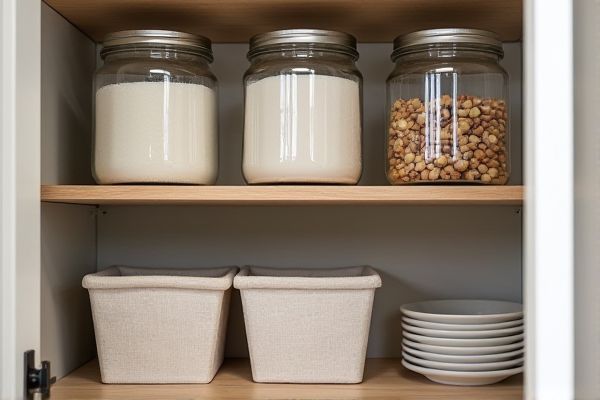
Soft bins in a pantry offer flexible, lightweight storage that adapts to various container shapes and sizes, while hard bins provide sturdy, stackable organization ideal for heavier items and long-term storage. Discover how choosing the right type of bin can transform Your pantry into a more efficient and accessible space by reading the rest of the article.
Table of Comparison
| Feature | Soft Bins | Hard Bins (Pantry) |
|---|---|---|
| Material | Fabric, mesh, or soft plastic | Plastic, metal, or wood |
| Durability | Less durable, prone to tearing | Highly durable, long-lasting |
| Flexibility | Flexible, collapsible for storage | Rigid, fixed shape |
| Weight | Lightweight | Heavier |
| Cleaning | Machine washable or wipeable | Easy to wipe and sanitize |
| Usage | Good for lightweight, soft items | Suitable for heavy or bulky pantry goods |
| Stackability | Often less stackable | Designed to stack securely |
| Cost | Generally lower cost | Usually higher cost |
Introduction to Pantry Organization: Soft Bins vs Hard Bins
Soft bins offer flexibility with lightweight, collapsible designs ideal for storing various pantry items, enhancing accessibility and space utilization. Hard bins provide sturdy, rigid structures that protect contents from crushing and are better suited for heavier or bulkier pantry goods. Selecting between soft and hard bins depends on storage needs, durability requirements, and ease of handling within pantry organization.
What Are Soft Bins? Advantages and Uses
Soft bins are flexible, fabric-based storage containers ideal for organizing pantry items, offering lightweight and collapsible design for easy storage when not in use. Their breathable material helps maintain food freshness by allowing air circulation, reducing moisture buildup compared to hard bins. You can efficiently use soft bins to group snacks, spices, or baking supplies, making pantry organization more accessible and visually appealing.
Hard Bins Explained: Features and Benefits
Hard bins in pantry storage are durable containers made from rigid materials such as plastic or metal, offering sturdy protection and maintaining shape even when fully loaded. Their solid construction prevents crushing and moisture infiltration, ideal for organizing bulk items like grains, pasta, and snacks while enhancing shelf space efficiency. These bins often feature tight-fitting lids to preserve food freshness and provide easy stacking, contributing to a clutter-free and hygienic pantry environment.
Material Comparison: Durability and Maintenance
Soft bins made from fabric or flexible plastic offer lightweight convenience and are easy to clean with simple spot washing, but they lack the structural rigidity of hard bins, making them less durable under heavy loads. Hard bins, typically constructed from materials like rigid plastic or metal, provide superior durability and resistance to wear, offering long-term maintenance benefits with straightforward cleaning methods such as wiping or washing. The choice between soft and hard bins in pantry storage hinges on balancing the need for durable, low-maintenance solutions with flexible, lightweight options suited for less demanding storage.
Space Optimization: Which Bin Suits Your Pantry Layout?
Soft bins offer flexible, collapsible storage ideal for irregularly shaped or limited pantry spaces, maximizing vertical and corner areas without rigid size constraints. Hard bins provide sturdy, stackable solutions that maintain consistent shape and volume, making them optimal for uniform shelves and heavy items. Choosing between soft and hard bins depends on pantry layout: soft bins suit adaptable, variable spaces while hard bins excel in structured, evenly spaced shelving systems.
Aesthetics: Visual Appeal in Pantry Design
Soft bins offer a versatile and cozy aesthetic with fabric textures that add warmth and softness to pantry spaces, enhancing a homely and inviting atmosphere. Hard bins provide a sleek, polished look with rigid materials such as plastic, metal, or wood that create clean lines and a modern, organized visual appeal. Choosing between soft and hard bins depends on desired pantry style, balancing tactile comfort with structured elegance for optimal visual impact.
Accessibility and Convenience: User Experience
Soft bins in pantries offer greater accessibility with flexible, lightweight containers that are easy to move and rearrange, enhancing user convenience during food retrieval. Hard bins provide sturdy, stackable storage that maximizes space efficiency but can be less adaptable for quick access compared to soft bins. Your pantry experience improves when using soft bins for frequently accessed items due to their ease of handling and better visibility.
Price Point Analysis: Budget Considerations
Soft bins typically offer a more budget-friendly price point compared to hard bins, making them ideal for cost-conscious consumers prioritizing affordability. Hard bins, often constructed from sturdy materials like plastic or metal, carry a higher initial investment but provide enhanced durability and long-term value. Analyzing the price per unit and lifespan helps determine the most cost-effective option for pantry organization based on specific budget constraints.
Best Uses: When to Choose Soft Bins or Hard Bins
Soft bins are ideal for lightweight, bulky pantry items like snacks, bread, or produce that require flexibility and easy access. Hard bins offer sturdy support for heavier items such as canned goods, jars, and bulk staples, ensuring durability and stackability. You should choose soft bins for versatility and portability, while hard bins are best when durability and structure are priorities in your pantry organization.
Final Verdict: Which Bin is Right for Your Pantry?
Soft bins offer lightweight, flexible storage ideal for easy access and space efficiency in small pantries, while hard bins provide rigid, durable organization suitable for heavy items and long-term storage. For a versatile pantry setup, combining soft bins for lightweight items like snacks and reusable bags with hard bins for canned goods and bulk staples maximizes functionality. Choosing the right bin depends on your pantry's size, item types, and accessibility needs, with soft bins excelling in portability and hard bins ensuring stability.
 homyna.com
homyna.com